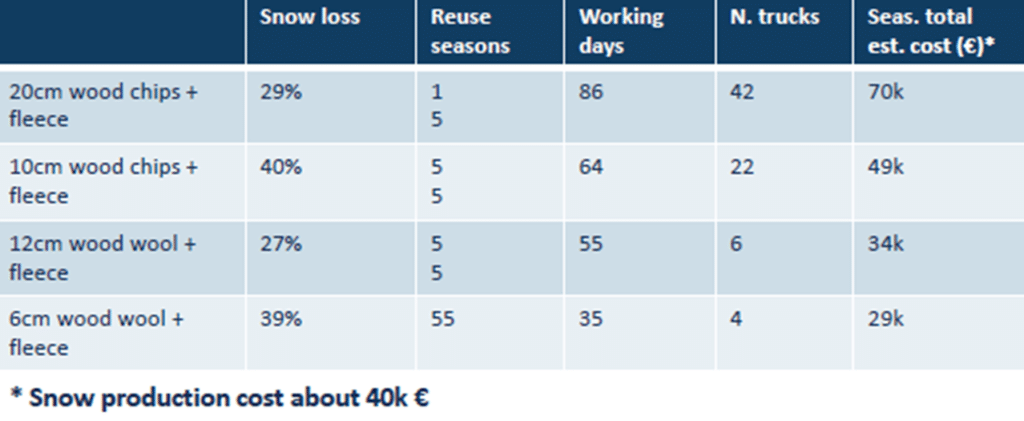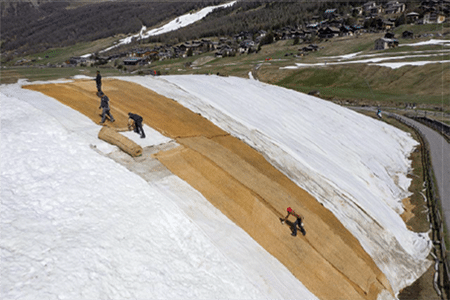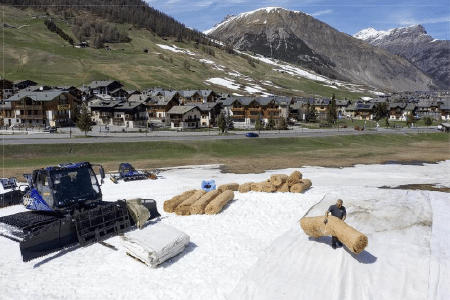After welcome words from the IBU, Fabian Wolfsperger from the WSL Institute for Snow and Avalanche Research SLF in Switzerland summarized the current state of sustainable snow practice in Europe within existing constraints: micro-climate, water, energy consumption, ecological elements, and social and economic factors.
“In Europe, resorts use snow storage and production to guarantee reliable snow coverage. Research has shown that about 70% of the costs associated with snow management are related to transporting snow (spreading, grooming, etc.). The data on the water and energy footprints of snow management has also been collected.”
Erik Melin-Söderström from Peak 63 in Östersund, Sweden, presented the process of gathering best practices – encompassing technology, techniques, planning, investment, and know-how – for making snow management more efficient and sustainable.
Jan Skricka, who is the Secretary General at OC Nove Mesto na Morave in the Czech Republic, talked from his experience at the IBU World Championships this season.
“The World Championshi
ps 2024 are not an example of a truly sustainable event due to the extensive snow production and the need for large-scale snow transportation to make the event possible. Warm weather and unseasonable winds characterized the lead-up to the event. 45,000m3 of snow was produced, with 10.280m3 of it transported to location.”
Skricka also identified good practices including:
Fabian Wolfsperger outlined a high emission scenario, with a possible 3-7 temperature degree increase in the Alps by the end of the century. He pointed out that climate experts predict that over the next 30 years, there will be 60-80% less natural snow around altitudes of 2000m.
Erik Melin-Söderström added that the IBU season 2023/2024 has seen warm weather creating soft conditions. His guidance included keeping the snow clean, preventing air pockets, using machine spreaders for salting, and investing in state-of-the-art snow-making.
Janez Ožbolt from OC Pokljuka, Slovenia, explained how unusually warm weather during the IBU Junior Cup in early December 2023 caused issues with water accumulation in the stadium, requiring extra workforce and energy to pump it out.
Kinga Jaworek from OC Jakuszyce, Poland, listed lessons learned from the venue’s debut in the IBU calendar. These included a motivated team and volunteers who feel ownership of the event, a flat surface, a new snow management system, and a robust snow production plan utilising every opportunity to produce snow.
Dr Fabiano Monti, snow and avalanche expert, talked about the evolution of the practices used in Livigno, Italy in using wood wool that can be reused, leaves the snow clean, and takes 1-2 days to install. Additionally, a snow damper is now used to transport the snow, saving about 20% of the snow.



Joakim Bergström who serves as CEO of Winn Marketing AB and is responsible for PistenBully Groomers in Scandinavia, and Lars Lind Andreasen who is Managing Director, Prinoth AB in Sweden, talked about the technological aspects of sustainable grooming in the future, listing different alternative fuels available with biofuels currently the most sustainable option for grooming, while other technologies such as electric and hydrogen powered machines are expected to slowly take market shares and develop further.
Ingrid Beutler, Co-founder, Sustainable Mountain Alliance, pointed out that the SIEPPUR project includes highly diverse venues – regarding ownership, operations and environmental regulations – from around Europe ranging from large, top modern World Cup ski venues to smaller, less developed, or developing ski areas.
Martin Ohlsson from the Swedish Biathlon Federation, Kimmo Turunen, President of the Kontiolahti Ski Club, Finland, and Dr. Marlen Marconi, Head of Strategic Projects, Swiss-Ski, Switzerland, talked about the importance of close cooperation of all parties – including municipalities – when managing a venue that hosts national teams, the BMW IBU World Cup events and numerous smaller events for youth and local population.
In the future, the importance of understanding the needs of the customer groups that a given snow sports venue serves and tailoring its snow management strategy to those will be critical for the venue’s long-term success.
Before the closing remarks, Fabian Wolfsperger announced additional research subjects for the framework of the SIEPPUR project that will follow in the second half of the project:
1. Snow storage is often distributed on green fields. Can we protect the snow track better from melting with wind fences or shadowing?
2. Grooming: if using stored snow for track preparation is coarse-grained, how can sintering or liquid water assist?
3. Snow-making: How secure is it to produce snow at a particular time of year based on information on the expected snow production?

| Time | Topic | Speaker |
| 14:00-14:05 | Welcome |  Max Cobb, IBU Secretary General Max Cobb, IBU Secretary General |
| 14:05-14:10 | Introduction to the SIEPPUR project & IBU Snow Network |  Riikka Rakic, IBU Head of Sustainability Riikka Rakic, IBU Head of Sustainability |
| 14:10-14:20 | The Science of Snow: Current state of sustainable snow management in Europe |  Fabian Wolfsperger, Sport Engineer, WSL Institute for Snow and Avalanche Research SLF, Switzerland Fabian Wolfsperger, Sport Engineer, WSL Institute for Snow and Avalanche Research SLF, Switzerland |
| 14:20-14:30 | Good Practices in sustainable snow management |  Erik Melin-Söderström, Project Manager, Peak 63, Sweden Erik Melin-Söderström, Project Manager, Peak 63, Sweden |
| 14:30-14:50 | Case Study – Nové Město na Morave, Biathlon World Champs 2024 Czech Republic |  Jan Skricka, Secretary General, Nové Město na Morave, Organising Committee (OC), Czech Republic Jan Skricka, Secretary General, Nové Město na Morave, Organising Committee (OC), Czech Republic |
| 14:50-15:15 | Examples of Sustainable Snow Management – Snow Production, Storage, Transport, Handling, Grooming | Moderated by:
Examples by:
|
| 15:15-15:30 Coffee Break | ||
| 15:30-15:50 | Future of sustainable grooming |
|
| 15:50-15:55 | Gap analysis – Summary |
Erik Melin-Söderström, Peak 63 |
| 15:55-16:20 | Panel Discussion – Governing snow management | Moderated by:
Panellists:
|
16:20 – 16:25 | SIEPPUR Project Next Steps |  Fabian Wolfsperger, WSL SLF Fabian Wolfsperger, WSL SLF |
| 16:25-16:30 | Q&A Closing Remarks |  Riikka Rakic, IBU Riikka Rakic, IBU |